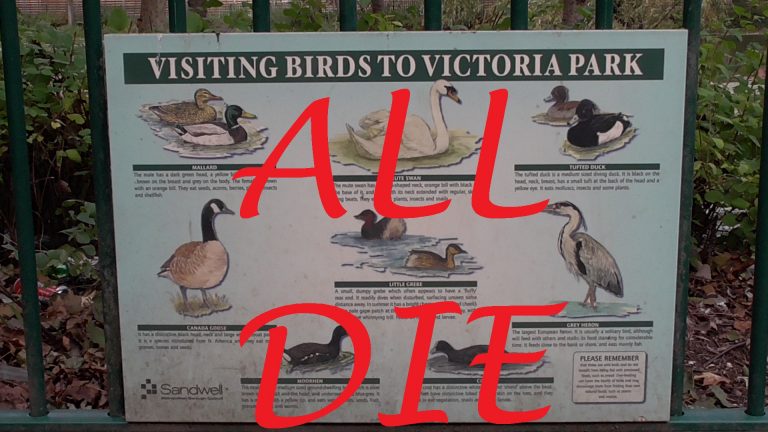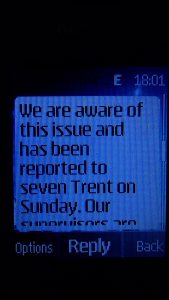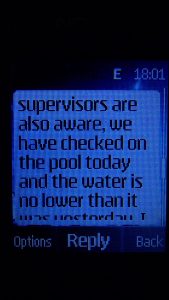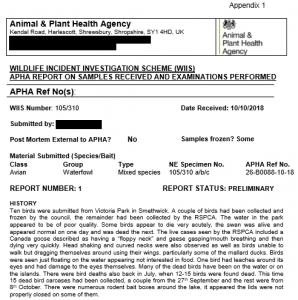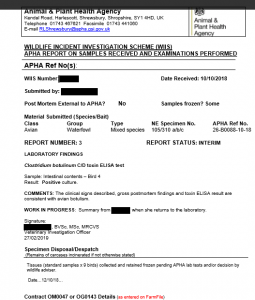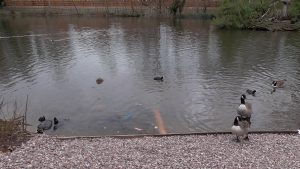I have previously set out my shear disgust at Sandwell Council’s abysmal handling of the draining lake at Victoria Park Smethwick in connection with the numerous bird deaths that have coincided with this. The email chain evidence from this is clear.
I can now report on the response from them to my letter of complaint, and after further enquiries and FOI requests, shed some more light on the continuing situation.
It is worth however recapping some of the key events leading up to this.
- A report in The Express and Star regarding complaints by members of the public concerning dead birds that had been in the lake “for weeks” appeared on 6/8/18
- Media appearances and comments by Cabinet member Bill Gavan made no reference to the draining pool and at this point the officers of SMBC appeared unaware of this issue.
- I pointed out the issue of the draining lake, which has occurred on at least two previous occasions, the last in 2016.
Here is an email which confirms how I reported this at this time, as up to this point I had been told by officers of SMBC that it was down to The Canal and Rivers Trust to fix- which was garbage.
 Here are screenshots of messages received from the then “street wardens” about this issue. They claim that the issue was reported to Severn Trent, that the correct officer was aware, and that their supervisor was also aware. Please note further on when Severn Trent claim to have had no previous reports about this issue at this time.
Here are screenshots of messages received from the then “street wardens” about this issue. They claim that the issue was reported to Severn Trent, that the correct officer was aware, and that their supervisor was also aware. Please note further on when Severn Trent claim to have had no previous reports about this issue at this time.
- I took a video of the RSPCA rescuing and retrieving ill and dead birds from the lake in October.
- I sent a complaint to Keep Britain Tidy regards how this park could have received a “green flag” award from their organisation given the dire conditions present there.
I received the following response from Max Cookson -Waste and Transportation manager SMBC on 11/12/18
“Dear Mr Carroll
Ref – Complaint Victoria Park, Smethwick
Thank you for your recent correspondence relating to Environmental issues/bird deaths at the above-named location. In respect of your claim that “no action has been forthcoming in fixing the damaged pool”, I can confirm the following facts.
- The foul water sewer which is defective and allowing water to escape from the pool is the responsibility of Severn Trent. Officers from SMBC have been in regular contact with Severn Trent since this defect was first discovered. However, as yet, Severn Trent (and/or their contractors) have yet to provide SMBC with a fixed date when the repair to this sewer pipe will take place. I am due to meet with Severn Trent this week. Should further delays occur in the repair of this sewer pipe SMBC will consider all available options open to remedy this matter.
Officers from SMBC have also been in constant contact with the RSPCA, and sought advice/guidance on how best to deal with the ongoing situation at the pool, with particular attention being paid to possible remedies regarding water aeration. The original advice from the RSPCA was not to aerate the water as this, along with possibly adding water to the pool following the extremely dry summer and low water levels (suggested prior to the discovery of the foul sewer break), may only serve to raise contaminants from the bottom of the pool. Furthermore, I am in possession of an E Mail from the RSPCA dated 15/11/2018 which confirms that all birds sent for Post Mortem by the RSPCA have had cause of death confirmed as Avian Botulism, the exception being one carcass that may have been the victim of a dog attack. Tests for Avian flu and viral enteritis all proved negative. This fact would therefore now negate your comment in your E Mail dated 13/9/2018 that Botulism has not been proven as a cause of bird deaths at Victoria Pool.
3 I can also now confirm that following further advice from the RSPCA (received 30/11/18), the use of aerators can be considered along with removal of a top layer of soil/silt from around the edge of the pool. SMBC staff are progressing with this matter.
4 With respect to the cleansing of the pool I can confirm that SMBC contractors were requested to cleanse the “Beach” area and around the edges of the pool in September of this year; however, as the cause of bird deaths was not yet confirmed the contractor sought further Health and Safety advice with regard to employees working in/around the water/water’s edge. This advice was provided by the RSPCA and subsequently the area was cleansed / litter picked in October.
Given the above facts, it is clear that both SMBC and our colleagues in the RSPCA have gone to great lengths to bring this matter to a successful conclusion, and will continue to do so.
The fact that we did not inform you of every action we took does not, in itself, mean we were not addressing the issues as a matter of urgency.
Based on the above, I would therefore refute your allegation that “No Action” has been taken with regard to the ongoing issues at Victoria Park pool. The Council, in association with the RSPCA, has worked diligently to identify the issues and has acted decisively and appropriately to try and resolve matters.
Yours sincerely
Max Cookson
Service Manager – Commercial Services”
After this letter, I set about confirming the voracity of many of the claims in Max Cookson’s letter. Continuing bird deaths and ill birds were noted at the site throughout. I can now report that many of Max Cookson’s claims are just not the case.
SEVERN TRENT
- Max Cookson claimed to have been in constant contact with Severn Trent, suggesting that it was their responsibility and that “Should further delays occur in the repair of this sewer pipe SMBC will consider all available options open to remedy this matter.”
I contacted Severn Trent who stated the following, also telling me that they have no records or reports of any repair prior to this having been undertaken by THEM to this same site and structure. This is most interesting as this obviously reveals that the bodge job carried out to fix this issue in 2016 (see above), and which I clearly pointed out to SMBC officers who were aware of it, must have been carried out by someone else. I WONDER WHICH AUTHORITY THIS COULD HAVE BEEN?
Ian Shaw of ST stated the following in an email of 7/1/19
“I’ve been asked to address your concerns in your email sent to our Customer Team.
We appear to have commenced investigations into this matter on 18/10/2018 following the problem being reported to us by Sandwell MB Council. They informed us they believed the low water level of the Victoria Pool was due our defective brick mains sewer & there appeared to be some missing bricks causing a hole through which the water was escaping. This was confirmed to be correct.
Unfortunately, we did take some time & many attendances (mostly in the early hours) to investigate this sewerage issue. The main problem was trying to cctv survey the large brick sewer but due to high flow rates we were unsuccessful. We liaised regularly with Sandwell MB Council during this period.
I can confirm that a temporary repair was completed on 21/12/2018.
We are presently investigating whether this sewer requires an immediate further / permanent repair, however, this would require a major engineering solution which would take some time to scope options & complete.
If you wish to discuss this matter further please contact me on my contact details below.
Regards
Ian Shaw
A number of points are noted here.
- SMBC officers complete lack of knowledge of their pool draining and not bothering to contact the authority they later claimed to be responsible for fixing the leak for MANY months after the deaths of birds-Severn Trent only investigating the bloody obvious on 18/10/18
- The claim of “a temporary repair” being made- more on this bollocks later.
RSPCA LIAISON.
Max Cookson claims to be working closely with the RSPCA on this matter, yet it is worth pointing out that despite delivering a cache of dead birds to SMBC to undertake post mortems, the same council had failed to progress this matter any further some weeks later. The birds were kept in poor refrigeration and were going off. They were eventually collected by the Wildlife investigation scheme officer, WHOM I CONTACTED ABOUT THIS ISSUE.
I can only state that the RSPCA officers involved in this matter have been VERY candid with me about what they think of Sandwell council and the manner in which they have dealt with this issue, and it is certainly a very different picture to the one Max Cookson is trying to present in this response!
Max Cookson then states that he is in
“possession of an E Mail from the RSPCA dated 15/11/2018 which confirms that all birds sent for Post Mortem by the RSPCA have had cause of death confirmed as Avian Botulism, the exception being one carcass that may have been the victim of a dog attack.”
I tested this statement by asking him for this said email.
For some reason he did not respond, but subsequently this was treated as a freedom of information request by SMBC – despite me not asking for it to be dealt with in this way. I received this email via the FOI on 22/1/19.
It is clear that Inspector Lasserre sent this email to John Satchwell of SMBC . He specifically states that having been on contact with the post mortem vet at the APHA they stated: “they can confirm all the carcasses, (bar one) show the typical signs of botulism.”
Let’s look at this statement in contrast to the one which Max Cookson stated in his letter to me of 21/12/18.
“an E Mail from the RSPCA dated 15/11/2018 which confirms that all birds sent for Post Mortem by the RSPCA have had cause of death confirmed as Avian Botulism, the exception being one carcass that may have been the victim of a dog attack.”
“they can confirm all the carcasses, (bar one) show the typical signs of botulism.”
Inspector Lasserre’s email DOES NOT state that all birds sent for post mortem by the RSPCA have had cause of death “confirmed” as avian botulism. “Typical signs” can relate to circumstantial evidence, but NOT proof. For that to occur, a specific test would need to be carried out to confirm botulism, and at the time of this email, and at the time of Max Cookson’s reply to me, THIS HAD NOT BEEN CONDUCTED.
I then put in an FOI request to the APHA – to see exactly what their perspective was. I had of course put in a preliminary FOI to them when SMBC had claimed to have sent off “birds” for post mortem– which was revealed to be just one duck– and not tested for botulism.
“Could you please supply me with the preliminary, supplementary and final reports concerning recent bird deaths at Victoria Park Smethwick boating lake, West Midlands- approximate nat grid reference SP025879.
These were submitted to the Shrewsbury laboratory around October. “
The APHA responded with 2 appendices.
The first can be read HERE.
This confirms that the WIS officer as a result if liaison with the RSPCA collected not only dead birds from the lake at the park, but also the ones that the RSPCA had previously delivered to the council- which they had failed to progress any further. IN ALL TEN BIRDS WERE SENT FOR POST MORTEM. Five geese, four mallards and one swan. The officer had also paid a visit to the lake.
“Ten birds were submitted from Victoria Park in Smethwick. A couple of birds had been collected and frozen by the council, the remainder had been collected by the RSPCA. The water in the park appeared to be of poor quality. Some birds appear to die very acutely, the swan was alive and appeared normal on one day and was dead the next. The live cases seen by the RSPCA included a Canada goose described as having a “floppy neck” and geese gasping/mouth breathing and then dying very quickly. Head shaking and curved necks were also observed as well as birds unable to walk but dragging themselves around using their wings, particularly some of the mallard ducks. Birds were seen just floating on the water appearing not interested in food.
One bird had leaches around its eyes and had damage to the eyes themselves. Many of the dead birds have been on the water or on the islands. There were bird deaths also back in July, when 12-15 birds were found dead. This time 15 dead bird carcases had been collected, a couple from the 27th September and the rest were from 8th October. There were numerous rodent bait boxes around the lake, it appeared the lids were not properly closed on some of them. “
The mallard (bird 4) had had beak and neck fractures- this suggests to me that this was vandalism- what other conclusion could be drawn? Similarly the goose (bird 5) also has suspicious injuries.
Further comments are described about internal examination.
The report states that AI was not detected in any of the birds and that the findings were “suspicious of botulism as the potential cause of death”. This conclusion is quite cautious in the absence of any test being a=carried out, though the findings on the injuries to at least two of the birds are not discussed which I find remiss on the part of the APHA. This cautious comment is howvere far from the direct statement given by Max Cookson.
Appendix 2 related to west nile virus (none detected ) but also stated that “WORK IN PROGRESS Intestinal botulinum toxin testing.” This then confirmed that no tests had been undertaken to confirm botulism by 1.2.19
I further queried if these test results had been returned in another FOI request.
“Thank you for your recent response to my freedom of information request ref APHA Ref No. 26-B0088-10-18 – bird deaths at Victoria Park Smethwick West Midlands.
As part of this submission it is stated that some of these birds deaths were ” suspicious of botulism as the potential cause of death”- but there is no proof of this from the post mortems. It also stated “WORK IN PROGRESS Intestinal botulinum toxin testing.” Can you confirm and release the results of these tests if they have been carried out?”
The APHA responded with this response.
“There is Clostridium botulinum toxin testing underway for submission 26-B0088-10-18, but as this test is carried out at an external laboratory it may take a while before we have a result. The Animal and Plant Health Agency (APHA) decided to carry out diagnostic testing on a few of the submissions from 2018 (which happened to include 26-B0088-1018) by selecting a few cases that were felt to be representative of the waterfowl die-off incidents during the summer.
A negative botulinum toxin test result would not rule out the diagnosis, as the toxin can become undetectable once it is bound to the nerve endings. In the majority of cases a diagnosis of botulism is made from gross post mortem findings without a supportive diagnostic test result, particularly when birds with consistent clinical signs have also been observed. The post mortem findings in all but one of the examined birds were consistent with botulism as the cause of weakness or death. In this case there were also clinical signs consistent with botulism in other birds on the site to further support this diagnosis.
There is more information available on the disease in the attached Appendix 1.
Please see Appendix 2 the third interim report. “
There are a number of observations here with this further information.
- There have yet to be confirmation of botulism as cause of death in these birds.
- The APHA state that bird 4 the mallard was tested for botulism intestinal contents, yet they ignore the injuries which ARE NOT associated with botulism in this case which I find bizarre.
- They then state that a negative test for botulism may not confirm that the bird did not die of botulism as it can be evanescent to detect. This is quite bizarre to me, as this same organisation would not make any positive diagnosis of bird deaths at Rattlechain lagoon from white phosphorus poisoning, (a substance equally evanescent in nature and that could only be detected from testing for this chemical. WP poisoning clinical signs are quite distinct in birds observed also.
The information supplied from the APHA avian botulism link (written July 2017) is also of interest about a number of points.
“Summary of disease
Avian botulism outbreaks in wild waterbirds occur relatively frequently in England and Wales.
The clinical signs are of a progressive flaccid paralysis. Affected birds are unable to use their wings and legs resulting in a loss of ambulation and inability to fly.
Large numbers of birds may be affected resulting in hundreds of deaths. Outbreaks can last for several weeks and may recur.
Affected birds may be paralysed for several days before dying or recovering, and this is a cause of concern for the public and public authorities.
There are no reported human health threats associated with Type C botulism in the UK. Prevention of drinking, swimming, bathing and water sports should be considered.
Environmental management and water engineering methods can be used to prevent environmental factors conducive to production of botulinum toxin in water bodies.”
“Avian botulism is a paralytic and often fatal disease caused by ingestion of toxin produced by the bacterium Clostridium botulinum. Avian botulism outbreaks in wild waterbirds occur relatively frequently in England and Wales. Large numbers of birds may be affected which can result in hundreds of deaths. Outbreaks of avian botulism can last for several weeks and may recur. C. botulinum is an anaerobic (oxygen intolerant) bacterium that multiplies in putrefying plant and animal material and is thus often found in lakes in periods of anoxic conditions and poor water quality.”
Incidents can occur anywhere in Britain and in any month. However, they are more frequent in warm summers. The clinical signs of a progressive flaccid paralysis are characteristic and provide a presumptive diagnosis. Affected birds are unable to use their wings and legs resulting in a loss of ambulation and inability to fly. Birds with paralysis of the neck muscles lose the ability to hold their heads normally (so-called limberneck). Birds can remain in this state for a number of days. Death is due to respiratory failure and / or drowning. Laboratory diagnosis of avian botulism is difficult as the tests used are relatively insensitive. “
“The APHA no longer offers diagnostic tests for botulinum toxin. “
The report also mentions the Management, control, and prevention of botulism outbreaks.
“All dead birds should be promptly removed as these are a potent source of toxin. The toxin may frequently be found in maggots feeding on dead birds and these represent an important way of toxin dispersal to feeding waterbirds. Sick birds should be removed, either for humane veterinary euthanasia or (with prior consultation) to a wildlife rehabilitation centre. “
CLEARLY SANDWELL COUNCIL HAVE FAILED TO DO THIS OVER A LARGE PERIOD OF TIME. IN MANY INSTANCES THEY HAVE LEFT THE RSPCA TO COLLECT ANY DEAD BIRDS.
“There are several techniques and water engineering devices that may prevent avian botulism incidents or reduce the severity of avian botulism outbreaks:
Treatment of lakes
C. botulinum bacteria and resistant bacterial spores are present in rotting material and in the lake sediments / silts. The following steps have been taken, particularly by London Royal Park authorities, and have prevented the recurrence of the disease or reduced its effects.
Preventative measures
Maintaining good circulation of water.
Maintaining healthy communities of oxygenating plants.
Prevention of the water level falling in the lake, preventing deoxygenation and the exposure of putrefying material.
Removal of decaying plant material (including leaves) from the water. In particular removing vegetative material that collects on branches dipping into the surface of the water. These branches should be removed.
If appropriate, removal of silts by pump action (in the face of an incident this may temporarily exacerbate the disease due to agitation of material).
Searching and removal of dead animals in high risk periods e.g. warm summer months.
The aim is to keep water levels high and reduce or lower the levels of silt.
Responses in the face of an avian botulism outbreak
Vigilance for and removal of all dead birds, as before – these are a potent source of toxin and toxin-contaminated maggots (such maggots can be eaten by waterbirds and cause disease).
Sick birds should be removed, either for humane veterinary euthanasia or (with prior consultation) to a wildlife rehabilitation centre. Increasing oxygenation of the lake by e.g. increasing circulation or raising the water level in the lake although care needs to be taken.”
- Drain the lake completely and remove silt and mud. This is easier in lakes with concrete bases. With the use of barrages, sections of the lake can be drained at a time with the water being pumped through special filter bags.
- Identify stagnant areas (dead areas) of the lake where toxin may be concentrated and target these areas for water circulation and oxygenation.
- Make the lake deeper by dredging, or by extracting silt using pumps; this slows the increase in water temperature (increasing water temperatures encourages toxin production).
- Employ large gauge (30 cm diameter mains) pumps. These are used to improve water circulation and to remove water from ‘dead areas’ and pump it to other areas using large bore pipes. Movement of this water over boulders / stones facilitates aeration of the pumped water.
Some lakes in London have wide bore pipes with inlet and outlet valves running the length of the lake, improving circulation of water and water oxygenation.
Inlet valves on the pumps and pipes which mechanically add air to the pumped water.
Employ floating pumps (like those used in fish farms). These remove water from the bottom levels and ‘dead areas’, and pump it over a ‘weir’ on the float causing aeration of water.”
“Morning Ian
Unfortunately, I’ve not received an update from my STW colleagues yet > I’ll chase immediately.
I did received a prompt reply from Sandwell MBC on 4th March:
1st reply – ‘I have not been made aware of any problems but will get it checked out’.
2nd reply – ‘Please see the image attached. It would appear that the water level has dropped at Victoria Park Smethwick again. Whilst I’m not 100% sure that the repair work has failed, the height of the pool water level suggests that the previous leak may have returned. Can we convene a meeting at the earliest possible convenience to look into this? Welcome your comments.
The temporary repair involved the covering of the exposed & defective brick type sewer with a strong tarpaulin sheet covered in sandbags to try to prevent any further deterioration / leakage, which seemed to work from initial inspections. We had thought about using a temporary inflatable dam but decided this would be a target for vandalism.
Can’t comment regarding dead birds & alleged avian botulism, as I was only informed that council were investigating with Environment Agency & RSPB.
Regards
Ian Shaw”

